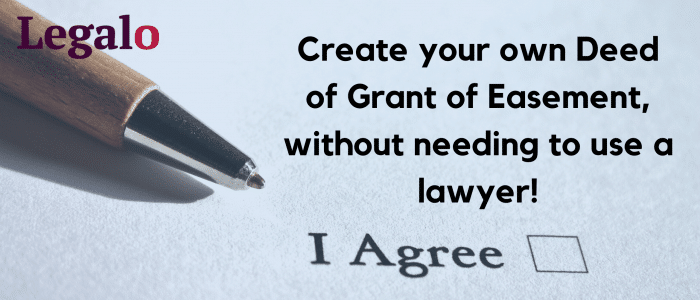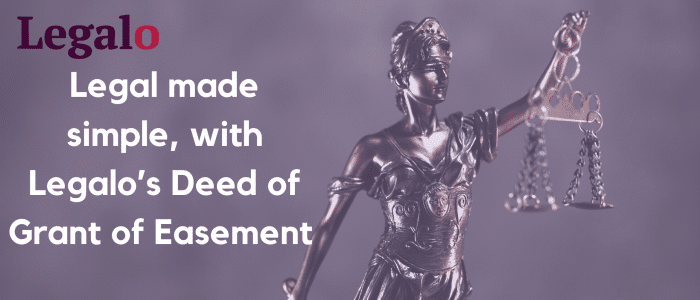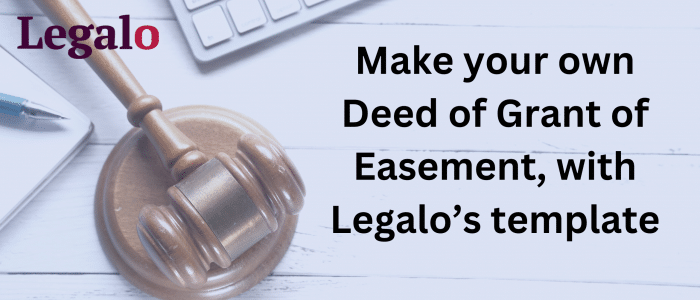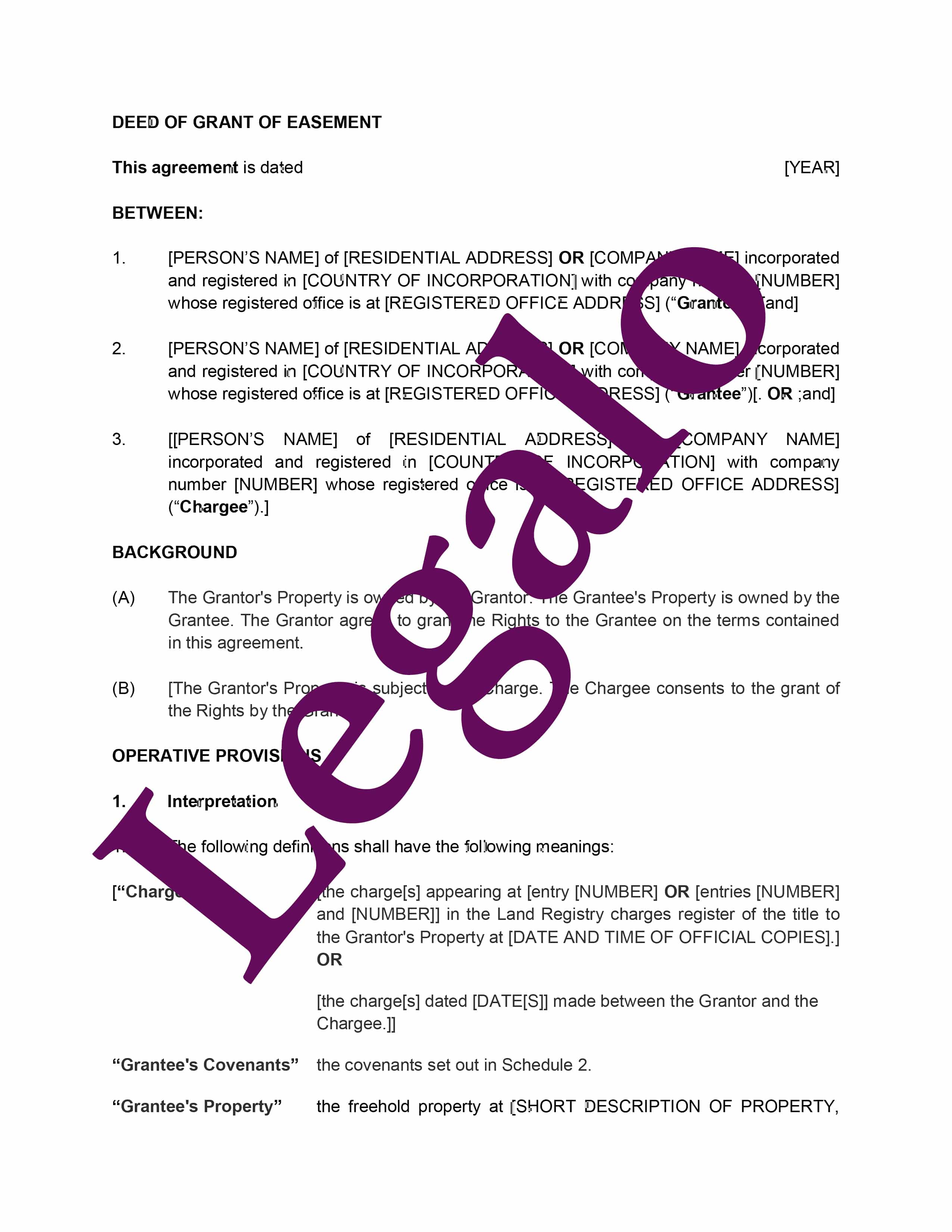Deed of Grant of Easement
Our deed of grant of easement template:
- Easily put in place a legally binding easement.
- Solicitor-drafted template for peace of mind.
- Full money-back guarantee if not satisfied.
- Step-by-step guidance notes included.
- Over 200 sold!

How Does It Work?
-
1. Download
-
2. Edit
-
3. Print
-
4. Sign
MD, Legalo Ltd; Solicitor; Notary Public
This is our Deed of Grant of Easement template. If you intend to grant an easement (such as rights of way, such as a shared driveway, or permission to run utility pipes or cables) for the benefit of adjoining land, then you can do so by using this template deed. Our guidance notes make it easy to complete this deed without prior legal knowledge. Use this deed for property based in England or Wales – do not use it for property based in Scotland.
Our solicitor and co-founder, David, has drafted this template deed, for reliability and cost-effective legal peace of mind. This document is suitable for residential and commercial property.
Use this deed to grant a “legal easement” by “express grant”. I.e. where both parties agree to the easement.
Now over 200 Deed of Easement templates sold!
What is a Deed of Grant of Easement?
A Deed of Grant of Easement will enable one property (known as a dominant tenement) to have rights over a piece of land (the servient tenement) that is owned by another party. There are many reasons that you might want to use a Deed of Grant of Easement. For example, if one property owner wants to grant a neighbouring property a right of way over their property. Granting a right of way is the most common reason that our customers use this template.
As with all of our commercial or residential property templates, the Deed of Grant of Easement is very easy to use and you will have no trouble downloading the template to your computer in Word format.
If you need to reuse this template at any time, you will have it available for no extra charge. If we update the template, we will notify you by email (you also get the updated version for free).
We include full guidance notes with the Word download. The notes take you through each step to completing the Deed.
You can view a sample of the Deed by clicking on the document ‘Preview’ button.
When to Grant an Easement Over Property
There are many situations when you would use the Deed of Grant of Easement. A common example is when the owner on an adjoining piece of property needs to cross your property. This could occur if they need to put a small portion of their driveway on your land, because of the location of the boundary lines.
Another reason you may have to use a Deed of Grant of Easement is if the tenant on the land next to yours must place underground services. There may be a need to dig a ditch on your property to provide for utilities supplying a neighbouring property. For example, this might be for mains water, sewerage, electricity, gas, television, cable or phone lines.
The Deed of Grant of Easement will state the terms of the easement. Therefore, it will not permit any no unnecessary use of the land. You could also use a clause in a conveyance deed or a transfer deed. However, it is better to use a template that we have designed specifically for this purpose.
When you purchase the template from us you will find that filling it out will only take a short time. We have designed the template (like all of our commercial property templates) to be very inclusive yet easy to use. You can buy your Deed of Grant of Easement with confidence from our website.
How To Use Our Grant of Easement Template
Once you have downloaded the template, you fill in the Deed of Easement template just like a form. Read the guidance notes first. Then work your way through completing the Deed using the template. You can sign the deed once you have drafted it. Both parties must sign the Deed of Variation in the presence of a witness.
What is a deed of easement?
A deed of easement gives the grantor simple rights over the land to the grantee. The grantee will make a payment to the grantor for these rights. It may be that any lender if there is a mortgage on the land will need to be notified and may need to give consent to the deed.
How do I create a deed of easement?
You create an easement by either:
- a written deed from the owners of the land through which the easement passes to the party who benefits from the easement; or
- on selling the land, the seller stating that the new owner of the land or part of the land must use it for the specific purpose of the easement, for example a right of access.
How much does a deed of easement cost in the UK?
At Legalo we provide you with a fully comprehensive, totally customisable deed of easement at a bargain price. Buy it today!
You can then apply to register it at the Land Registry, using the forms that are free from the Land Registry’s website and save even more in legal fees.
What are the three types of easements in the UK?
- a right to light;
- right of way (including the right to use a parking space); and
- a right of support.
What are the requirements of a legal easement?
- There must be 2 properties: the one that grants the benefit and the one that receives it;
- The 2 pieces of land must be adjacent and neighbouring to one another;
- The easement must clearly be for the benefit of the land receiving the right (not just of benefit to the owner of the land);
- The properties must have different owners; and
- The rights must be capable of grant.
This last requirement includes various elements:
(1) The rights granted cannot exceed the land owner’s own rights.
(2) The deed must state the rights clearly.
(3) The easement must be of the type that English law normally recognises as being an easement. Generally, this excludes negative rights (the right to stop the other landowner doing something lawful on their land).
(4) The right must not impose a costly duty on the land owner granting the right, such as a duty to supply a utility service, rather than just to run a utility supply over the land.
(5) The easement must not equate to full and exclusive use of the grantor’s piece of land.
Does a deed of easement need to be registered?
In order for the easement to be legally binding then if the land is registered with the Land Registry the deed of easement will need to be registered using Land Registry form AP1. However, if the land is not registered then the deed cannot be registered and will be an equitable easement or an easement that can only bind those parties subject to the agreement who knew about it. A legally binding easement will bind all parties whether or not they were aware of the agreement.
What happens if an easement is not registered?
If you have not registered the easement, then it will exist, as we have discussed above, as an equitable right. That is a right that only binds the person who is aware of it. In this case, this will be the person who originally granted it. If the owner sells the land the easement would no longer exist, as it would no longer be binding on the purchaser who buys it without knowing about it. The only solution is to register it.
Do easements transfer to new owners? Is a deed of easement transferable?
Only if you have registered the easement at the Land Registry and so it then “runs with the land”. A deed of easement is only transferable with the land to which it relates. When the owner sells the land, they sell it with the rights the easement grants.
Can a deed of easement be revoked?
It may be possible to remove an easement if you can show that the reason for the easement no longer exists. In most cases this would not be possible.
Is SDLT payable on a deed of grant of easement?
In theory, yes, SDLT could be payable on a deed of easement. However, most easements are not expensive and therefore fall below the SDLT threshold. If you bought a particularly expensive right of way, it might in theory attract SDLT. If you buy the easement from the person who sells you the land that the easement benefits at the same time, then you add the value of the easement to the price of the land, as the 2 transactions are connected, when you work out the SDLT.





